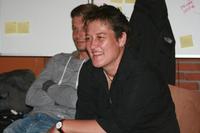Vera van der Grift, IRC Information Officer interviewed Alana Potter, IRC Senior programme officer on how the life-cycle costs approach is being applied to the hygiene-related work of IRC’s WASHCost and partners.
Published on: 21/09/2012

In order to achieve the intended health and livelihoods benefits, improved water and sanitation services must be used effectively and hygienically. Improved water and sanitation services are key to having an impact on sustainable health and livelihoods. In general, hygiene promotion and user education is included as an intervention during the process of water and/or sanitation infrastructure improvement, indeed as a means to stimulating demand for these services. These interventions are linked up to hygiene promotion services through public district health services or environmental health services.
It is difficult to demonstrate the impact of software implementation on behaviour change and facilitation. It is equally difficult to monitor software implementation and to prove that it is making a real change to people’s hygiene practices. Because of this, the budget for this kind of support is often under threat. It is much easier to see investments in capital expenditures because you can see a pump, a pipe, or a toilet. But facilitation, training and support, and facilitating behaviour change are harder to track and they are therefore, arguably, not sufficiently resourced.
Through its hygiene effectiveness work in the water and sanitation service delivery process, WASHCost is trying to build the evidence base for continued investment in hygiene promotion and other software.
We identified three key behaviour changes that most hygiene and sanitation promotion programmes facilitate. These are: hand washing with soap or substitute at critical moments; the use of sanitary latrines by all family members all the time; and, of course, safe household water management and use. We were able to evaluate the effectiveness of these programmes by comparing baseline and end line data on these three key behaviours. This in turn is building the evidence base, and our understanding of the types of programmes that result in the greatest efficacy.
In addition, we are comparing the costs of planning, designing, implementing, monitoring and managing hygiene promotion and other software interventions throughout the course of the service delivery. This gives us an informed perspective about the costs and the benefits of hygiene promotion and other software approaches and methodologies in the water and sanitation delivery process.
Given that most countries have adopted a position that rural sanitation is a household responsibility, hygiene promotion and related CAPEX software interventions are often key to the sustainability of WASH services in rural areas.
We are undertaking hygiene cost effectiveness studies in four WASHCost focus countries: Ghana, Burkina Faso, India (Andhra Pradesh) and Mozambique. The studies compare different types of hygiene promotion approaches and methodologies in these four countries. Ultimately, the studies will give us a comparison of before and after the intervention in each country and between countries. It will also give us other valuable comparisons such as between methodologies like CLTS and more traditional approaches to facilitating hygiene promotion; and it will give us information on behaviour change in terms of water and sanitation use, and CLTS mixed with hygiene promotion and/ or sanitation marketing in these countries.
In this way, through the studies we will obtain comparisons on three levels: between countries, between methodologies, and before and after interventions.
In many countries, health services, including primary health care and public and environmental health are being decentralised from provincial to district level. District health services are starting to coordinate and pull together various interventions, programmes and campaigns into a more coherent whole. It will then be able to provide a better service in respect to primary health care and hygiene promotion.
While this process is still in its infancy in many countries, the WASHCost hygiene promotion cost effectiveness study can start to contribute an indication of both the effectiveness of different approaches and the kinds of per capita costs involved in effective hygiene promotion. This is interesting and important information in moving district health planning forward.
For additional information on preliminary findings on the per capita costs see:
Reep, M. van de, 2010.A cost analysis of hygiene promotion interventions in Mozambique: paper presented at the IRC symposium ‘ Pumps, Pipes and Promises: Costs, Finances and Accountability for Sustainable WASH Services' in The Hague, The Netherlands from 16 - 18 November 2010. [online] http://www.washdoc.info/docsearch/title/173156
Vera van der Grift, IRC Information Officer
21 September 2012